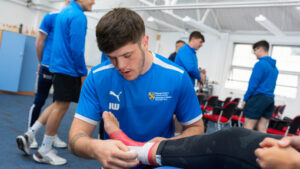From Beginner to Pro: Progressing Your Paddleboarding Workout

Paddleboarding, with its serene waters and picturesque views, is a fantastic way to stay fit and have fun. But, if you’re just at the start of your journey, you can feel nervous about getting on the water. Know that many people feel this way. But, it won’t be long before you call yourself a pro and regularly work out on the water. Here is a guide that can help you go from a beginner to a confident pro paddleboarder.
Starting as a Beginner
If you’re new to paddleboarding, don’t worry; everyone starts somewhere. Here are the basics to get you going.
Selecting the Right Equipment
Paddle Boarding begins with choosing the right board and paddle. As a beginner, opt for a wider and more stable board to help you find your balance. Investing in a quality inflatable board is often a great choice as they are easy to transport and store.
Safety Considerations
Safety should be your top priority. Always wear a personal flotation device (PFD) and use a leash to keep you connected to your board. Familiarise yourself with the water conditions, tides, and currents in your chosen location, and never venture too far from shore as you’re getting started.
Enjoy Short Workouts
When you first start paddle boarding, it’s normal to get excited and want to head out on a huge adventure. But, this is how you can overdo it. You won’t be used to the workout, which will lead to having sore muscles and feeling stiff. You also burn calories when you paddle board, so you have to get used to this activity. Thus, stick to short workouts on the paddleboard until you can get used to it and build some strength. You could be uncomfortable for days otherwise.
Building Core Skills
Mastering balance and paddle techniques are the foundation of paddleboarding. Here’s how to develop these core skills.
Balance and Stability
Improving your balance is key. Start by practising on calm, flat waters. Begin on your knees and gradually work your way up to standing. Engage your core muscles to maintain stability, and remember, it’s normal to take a tumble or two as you learn. Don’t be embarrassed. If you want to learn quickly, you might benefit from going to a class. This can help you learn from trainers and experts. They’ll know the best ways to teach you for success.
Paddling Techniques
Learn the proper paddling techniques, including how to hold the paddle, the paddle stroke, and turning manoeuvres. Practise these techniques to become more efficient and confident on the water. There are plenty of videos on the internet that you can watch and learn from. Browse on YouTube and other platforms to find them.
Going Beyond the Basics
Once you’ve mastered the basics, it’s time to take your paddleboarding to the next level:
Advanced Paddling Techniques
Explore advanced techniques like the pivot turn, crossbow draw, and bracing strokes. These manoeuvres will make you more versatile on the water. Just take your time so that you can master them and feel confident.
Tackling Different Water Conditions
Challenging yourself with different water conditions, such as waves and currents, will hone your skills and test your abilities. It’s an excellent way to progress from a casual paddler to a pro. Again, the important aspect here is to feel confident. You want to feel like you’re in control of these different water conditions.
Nutrition and Hydration for Paddleboard Fitness
Staying fit isn’t just about your workouts; it’s also about what you eat and drink. If you want to build muscle and have energy, you have to eat the right foods and stay hydrated.
Balanced Diet
A well-rounded diet is essential for overall health and fitness. Ensure you’re getting a mix of nutrients, including lean protein, carbohydrates, healthy fats, and plenty of fruits and vegetables. Before you hit the water, eat something light that will give you energy. You can even bring a few snacks for the journey.
Hydration
Proper hydration is crucial, especially when you’re out in the sun in the summer. Drink enough water to keep your energy levels up and stay alert on the water. Again, you can bring a bottle of water with you if you have a secure place on your board. This might be exactly what you need when it’s hot, and the sun is blazing down.
Setting Goals and Tracking Progress
To continually improve your paddle boarding skills, it’s essential to set goals and track your progress.
Goal Setting
Define specific fitness or skill-based goals to work toward. Whether it’s mastering a new paddle technique or completing a long-distance paddle, having goals keeps you motivated.
Progress Tracking
Document your progress through a paddleboarding journal or an app. Seeing your improvements over time can be incredibly motivating.
Conclusion
Your paddleboarding journey is an ever-evolving one, filled with opportunities for growth and exploration. Whether you’re just starting or well on your way, remember that progression is a continuous process. Embrace each step of the journey, set your sights on your goals, and enjoy the incredible fitness and adventure that paddleboarding offers.





